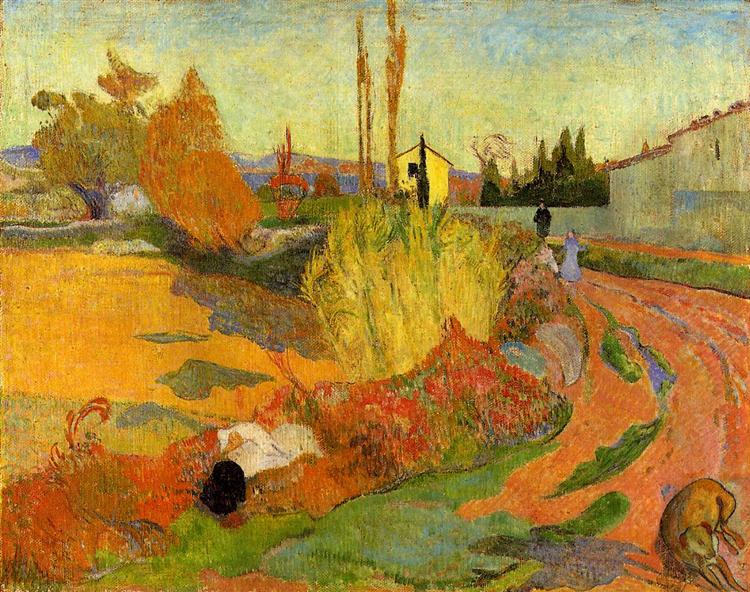Beskrivelse
Maleriet "Landskab i Arles" af Paul Gauguin, lavet i 1888, fanger et af de mest betydningsfulde stadier af kunstnerens karriere, hvor han oplevede med farven og formen på en dristig måde og bliver en af forløberne for symbolik i symbolikken i symbolikken i maleri. Dette arbejde indsættes i sammenhæng med dets ophold i det sydlige Frankrig i Arles, hvor Gauguin søgte et nyt billedsprog, der brød med de konventionelle repræsentationsnormer.
Visuelt er billedet kendetegnet ved dets livlige farvepalet, der resonerer med påvirkningen af det naturlige miljø, hvori det blev skabt. "Landskab i Arles" præsenterer et panorama af marker og træer, hvor grønne og gule toner skifter næsten legende, hvilket viser, hvordan sollys forvandler landskabet. Denne kontrast af nuancer giver ikke kun kompositionen, men taler også om Gauguins følelsesmæssige tilgang til naturen, hvor farvebrug bliver et mere beskrivende ekspressivt medium.
Værkets perspektiv er bemærkelsesværdigt. Horisonten er ret høj, som sammen med arrangementet af elementer i den nedre del af lærredet antyder en følelse af dybde og amplitude. I dette arbejde er naturen ikke blot en baggrund for den menneskelige figur, hvilket ofte er tilfældet i andre billedlige traditioner, men bliver en hovedperson i sig selv. Du kan se buske og træer, der, selvom de er stiliseret, fremkalder en tre -dimensionalitet, der inviterer seeren til at komme ind i landskabet.
Teknikken med synlige og gesturale børstestræk, som Gauguin anvendte, giver en taktil struktur til lærredets overflade, som understreger landskabets følelsesmæssige karakter. Disse børstestræk, der bevæger sig med en vis frihed, kontrasterer med den mest stive struktur, der findes i andre moderne værker, hvilket afslører Gauguins søgning efter et mere personligt og mindre akademisk udtryk.
Det er interessant at bemærke, at der i dette arbejde ikke er nogen menneskelige figurer, som er en vending med hensyn til mange af dens andre kompositioner. Dette kan afspejle et bestemt øjeblik af introspektion og kontemplation, hvor landskabet bliver et husly og et middel til forbindelse med essensen af at være. Denne undladelse af menneskelige karakterer giver også seeren mulighed for at fordybe sig fuldstændigt i miljøet med fokus på farver, former og lys uden distraktioner.
"Landscape in Arles" er et vidnesbyrd om den radikale ændring, som Gauguin oplevede i sin stil i denne periode. Selvom du stadig kan se ekko af din impressionistiske træning, peger dine valg i sammensætningen og brugen af farve til en ny retning, der vil blive kendetegnet i dine efterfølgende værker. Maleriet introducerer seeren i en sensorisk oplevelse med fokus på naturen såvel som den følelsesmæssige fortolkning, som Gauguin indsprøjter i sit landskab.
Kort sagt, "Landskab i Arles" repræsenterer ikke kun et specifikt sted og tid, men inviterer dig også til at reflektere over kunstnerens rolle i skabelsen af virkeligheden over lærredet. Det er et værk, der ud over at være visuelt attraktivt tilbyder et kig på Gauguins stilistiske udvikling og dets konstante søgning efter en kunst, der overskrider blot repræsentation, og kommer nærmere et visuelt sprog, der dialog med følelser og menneskelig oplevelse.
KUADROS ©, en berømt maling på din væg.
Håndlavede olie -malerier med kvaliteten af professionelle kunstnere og den karakteristiske segl af KUADROS ©.
Billeder reproduktionstjeneste med tilfredshedsgaranti. Hvis du ikke er helt tilfreds med kopien af dit maleri, refunderer vi dine penge 100%.

